Performance Investigation on a Double-Slope Passive Solar Desalination System Targeting towards Sustainable Development of Oman
Abstract
:1. Introduction
2. Experimental Section
3. Results and Discussions
4. Conclusions
- In this study, a double-slope solar still was successfully fabricated for a solar desalination system according to the geographical and climatic conditions of Nizwa city in Oman.
- The fabrication of the solar desalination system was done using readily available materials in the market at a very low cost suitable for domestic applications and, of course, for low-scale industries.
- We planned to measure the temperature at specific locations on the solar still and quantity of distillate obtained per day. Arduino programming with the Arduino UNO interface board was used in the study to record and display the temperatures at various locations on the solar still. This made the estimation of the thermal performance of the solar still effective due to the dynamic measurement of the temperature with respect to time daily.
- The intensity of solar radiation and ambient temperature significantly affected the performance of the desalination system, as subsequently it significantly influenced the heat absorption rate, evaporation, and condensation rates.
- An appreciable rise in cumulative water yield was observed after 12 h due to enough condensation occurring after 12 h, attributed to the heat absorption capacity of the system.
- The maximum condensation was noted after 13 h, which increased the yield significantly, the heat storage potential lasting for a longer period in the solar still.
- An energy efficiency ranging between 30 and 45% and exergy efficiency ranging between 2 and 3.5% were obtained in the system, which was reasonably better in a thermal system. This may be attributed to the fact that the thermal analysis was carried out for the entire system and not for the individual components in the desalination unit. The effect of exergy on the individual components of the solar was still ignored.
Author Contributions
Funding
Data Availability Statement
Conflicts of Interest
Nomenclature and Abbreviations
| T1 | Outer glass surface temperature in °C |
| T2 | Outer glass surface temperature in °C |
| T3 | Inner basin temperature in °C |
| T4 | Outer basin surface temperature in °C |
| T5 | Ambient temperature in °C |
| Iavg | Average solar intensity per day in W/m2 |
| Ts | Sun temperature in K |
| As | Basin surface area in m2 |
| I | Average solar radiation intensity in W/m2 |
| L.H | Latent heat |
| TDS | Total dissolved solids |
| pH | Potential of hydrogen |
| GPS | Global positioning system |
| DHT | Digital sensor for sensing temperature and humidity |
| HSS | Hemispherical solar still |
| CHSS | Conventional hemispherical solar still |
| MHSS | Modified hemispherical solar still |
| ppm | Parts per million |
| ASTM | American society for testing and materials |
| LED | Light-emitting diode |
| V | Volts |
| mA | Milli-amperes |
| C | Centigrade |
References
- Compain, P. Solar Energy for water desalination. Procedia Eng. 2012, 46, 220–227. [Google Scholar] [CrossRef] [Green Version]
- Tarawneh, M.S.K. Effect of Water Depth on the Performance Evaluation of Solar Still. Jordan J. Mech. Ind. Eng. 2007, 1, 23–29. [Google Scholar]
- Hafs, H.; Zaaoumi, A.; Bouramdane, Z.; Ansari, O.; Bah, A.; Asbik, M.; Malha, M. A Performance Analysis Study of a Single Slope Solar Still with Integrating Fins and Nanofluid for Productivity Enhancement. In Proceedings of the 1st International Conference of Computer Science and Renewable Energies (ICCSRE 2018), Ouarzazate, Morocco, 22–24 November 2018; pp. 342–348. [Google Scholar]
- Al Shabibi, A.M.; Tahat, M. Thermal Performance of a Single Slope Solar Water Still with Enhanced Solar Heating System. Proc. Int. Conf. Renew. Energy Power Qual. 2015, 1, 585–590. [Google Scholar] [CrossRef]
- El-Maaty, A.E.A.; Awad, M.M.; Sultan, G.I.; Hamed, A.M. Solar powered fog desalination system. Desalination 2019, 472, 114130. [Google Scholar] [CrossRef]
- Rai, V.; Tambat, M.; Shaikh, M.; Shah, S.; Mehta, S. Portable solar desalination Plant. Viva-Tech Int. J. Res. Innov. 2020, 1, 1–5. [Google Scholar]
- Gude, V.G.; Nirmalakhandan, N. Sustainable desalination using solar energy. Energy Convers. Manag. 2010, 51, 2245–2251. [Google Scholar] [CrossRef]
- El-Agouz, S.A.; El-Aziz, G.B.A.; Awad, A.M. Solar desalination system using spray evaporation. Energy 2014, 76, 276–283. [Google Scholar] [CrossRef]
- Ullah, M.A.; Ali, A.; Aslam, M.; Hayat Khan, K. Brackish Water Desalination Using Solar Desalination Panel. Curr. Investig. Agric. Curr. Res. 2018, 3, 1–5. [Google Scholar]
- Vaithilingam, S.; Muthu, V.; Athikesavan, M.M.; Afzal, A.; Sathyamurthy, R. Energy and exergy analysis of conventional acrylic solar still with and without copper fins. Environ. Sci. Pollut. Res. 2022, 29, 6194–6204. [Google Scholar] [CrossRef] [PubMed]
- Alawee, W.H.; Mohammed, S.A.; Dhahad, H.A.; Essa, F.A.; Omara, Z.M.; Abdullah, A.S. Performance analysis of a double-slope solar still with elevated basin—Comprehensive study. Desalination Water Treat. 2021, 223, 13–25. [Google Scholar] [CrossRef]
- Suraparaju, S.K.; Natarajan, S.K. Performance analysis of single slope solar desalination setup with natural fiber. Desalination Water Treat. 2020, 193, 64–71. [Google Scholar] [CrossRef]
- Gude, V.G.; Nirmalakhandan, N.; Deng, S. Desalination using solar energy: Towards sustainability. Energy 2010, 36, 78–85. [Google Scholar] [CrossRef]
- Savithiri, V.; El Hadi Attia, M.; Kabeel, A.E.; Vaithilingam, S.; Radhakrishnan, G. Enhancing the productivity of hemispherical solar distillation by using energy storage (rubber) and wick materials at different thickness. Sol. Energy Mater. Sol. Cells 2022, 248, 112006. [Google Scholar] [CrossRef]
- Krishna, A.R.; Kavitha, D. Influence of heat absorber materials sand, soil, and paraffin wax in solar still on sustainable water distillation. Case Stud. Chem. Environ. Eng. 2023, 8, 100365. [Google Scholar] [CrossRef]
- Abdullah, A.S.; Panchal, H.; Alawee, W.H.; Omara, Z.M. Methods used to improve solar still performance with generated turbulence for water desalination—Detailed review. Results Eng. 2023, 19, 101251. [Google Scholar] [CrossRef]
- Hawlader, M.N.A.; Dey, P.K.; Diab, S.; Chung, C.Y. Solar assisted heat pump desalination system. Desalination 2004, 168, 49–54. [Google Scholar] [CrossRef]
- Sivakumar, V.; Sundaram, E.G. Experimental studies on quality of desalinated water derived from single slope passive solar still. Desalination Water Treat. 2016, 57, 27458–27468. [Google Scholar] [CrossRef]
- Chen, Q.; Alrowais, R.; Burhan, M.; Ybyraiymkul, D.; Shahzad, M.W.; Li, Y.; Ng, K.C. A self-sustainable solar desalination system using direct spray technology. Energy 2020, 205, 118037. [Google Scholar] [CrossRef]
- Burhan, M.; Jin, Y.; Ybyraiymkul, D.; Ja, M.K.; Al Rowais, R.; Shahzad, M.W.; Chen, Q.; Ng, K.C. Long term rating (LTR) and energy efficacy of solar driven desalination systems in KSA using a common energy platform of standard solar energy (SSE). Sol. Compass 2023, 6, 100044. [Google Scholar] [CrossRef]
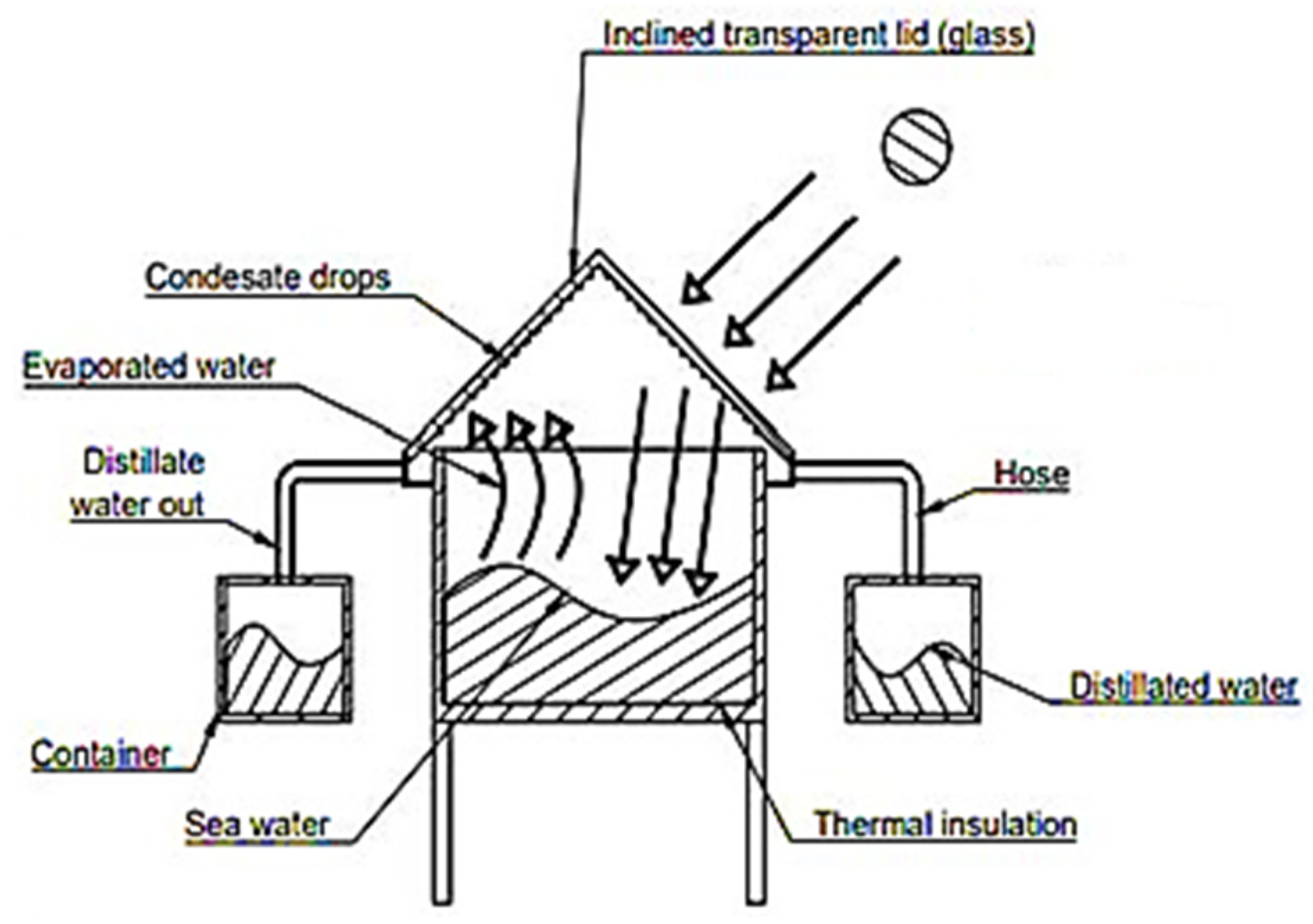
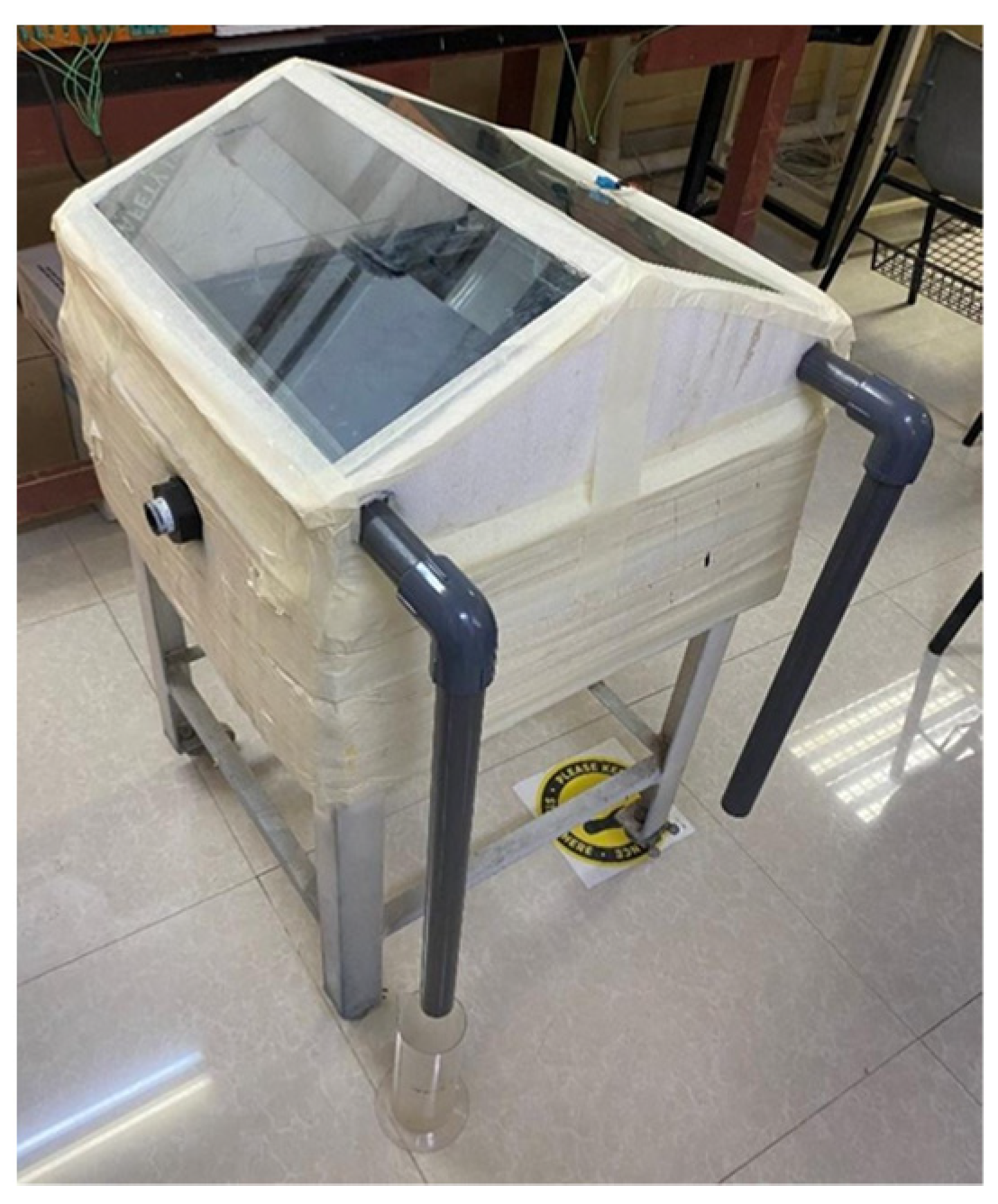

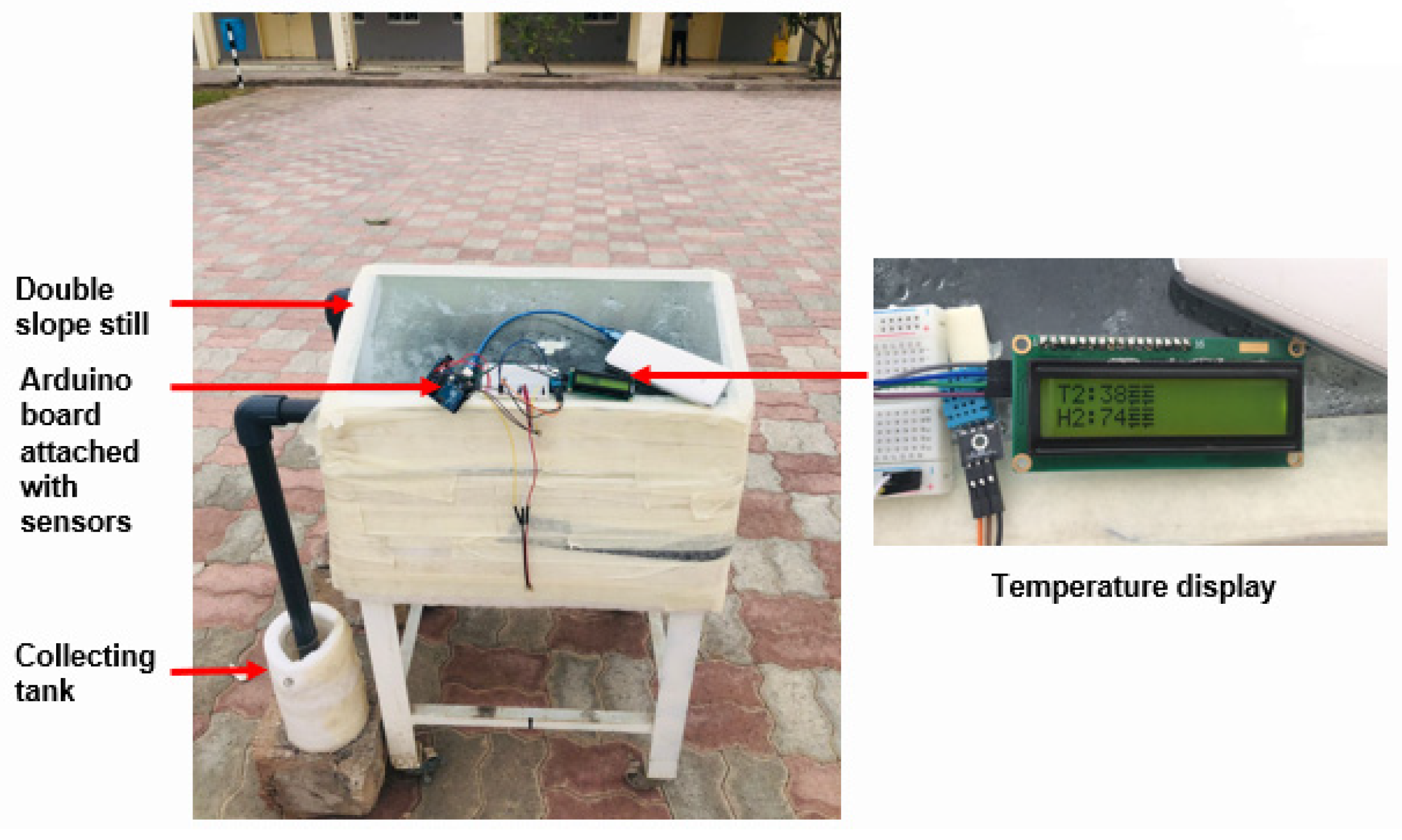
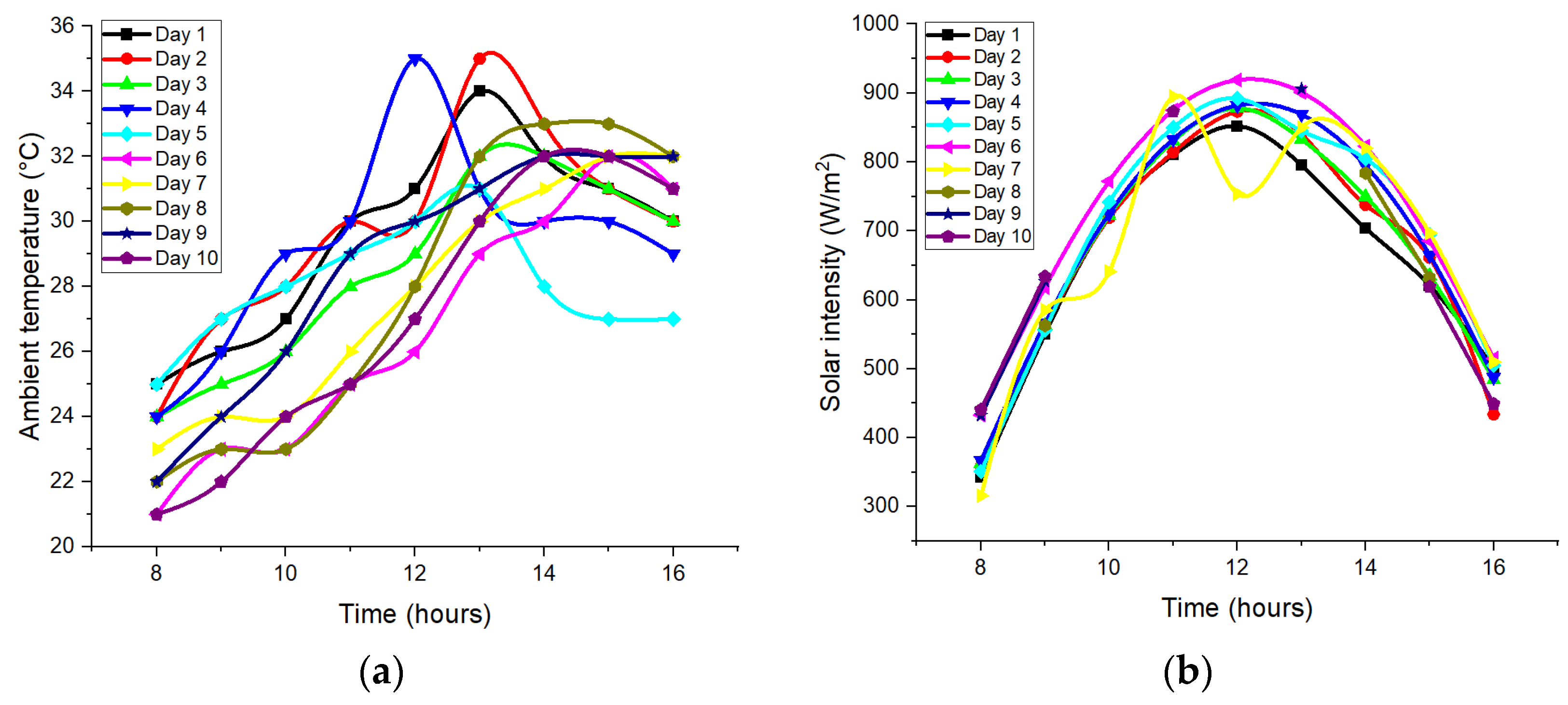


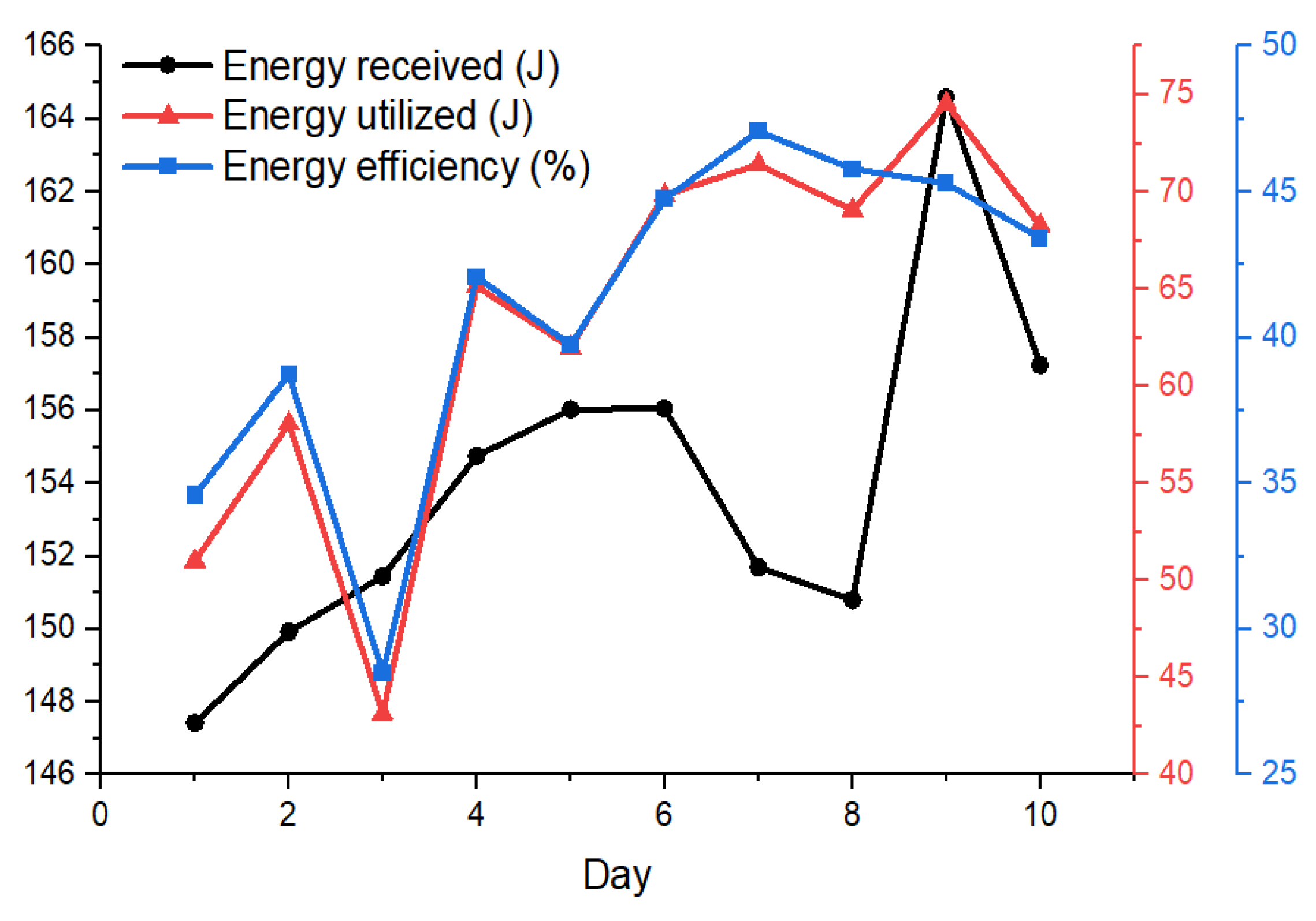
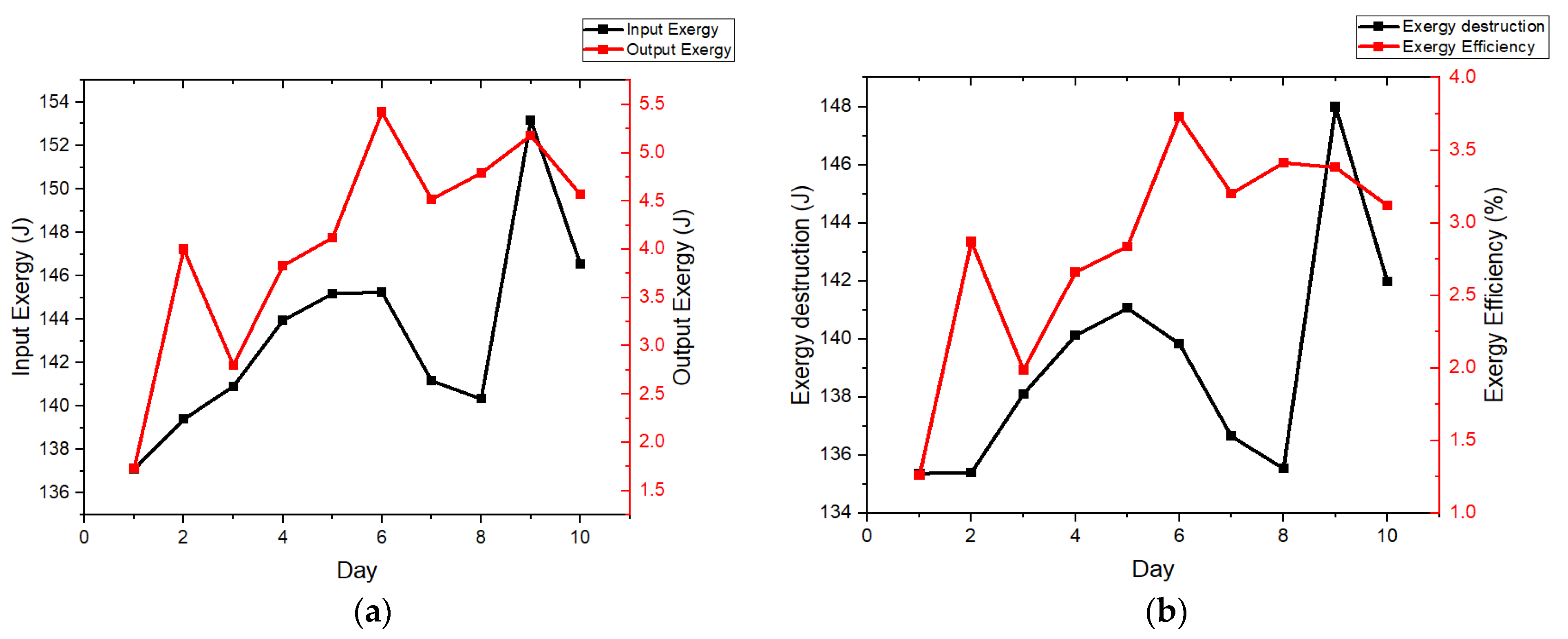
| S.No. | Component | Material | Specifications |
|---|---|---|---|
| 1 | Basin | Mild steel | 48.5 × 46.5 × 8 cm (or) 18 L capacity |
| 2 | Solar collector | Glass | 48.5 × 26 × 0.6 cm—2 nos. |
| 3 | Insulation | Glass wool | 20 mm thick for required length |
| 4 | Collection trough | Acrylic | 48.5 × 3 × 0.6 cm—2 nos. |
| 5 | Distillate tank | Plastic | 5 L capacity—2 nos. |
| 6 | Temperature sensor | DHT 11 | Voltage: 3.5 V to 5.5 V Operating current: 0.3 mA, Temperature: 0 °C to 50 °C, Humidity: 20% to 90% Accuracy: ±1 °C and ±1% |
Disclaimer/Publisher’s Note: The statements, opinions and data contained in all publications are solely those of the individual author(s) and contributor(s) and not of MDPI and/or the editor(s). MDPI and/or the editor(s) disclaim responsibility for any injury to people or property resulting from any ideas, methods, instructions or products referred to in the content. |
© 2023 by the authors. Licensee MDPI, Basel, Switzerland. This article is an open access article distributed under the terms and conditions of the Creative Commons Attribution (CC BY) license (https://creativecommons.org/licenses/by/4.0/).
Share and Cite
Radhakrishnan, G.; Breaz, D.; Al Riyami, K.A.A.; Al Nadabi, W.S.; Al Nadabi, T.Y.; Karthikeyan, K.R. Performance Investigation on a Double-Slope Passive Solar Desalination System Targeting towards Sustainable Development of Oman. Energies 2023, 16, 5917. https://doi.org/10.3390/en16165917
Radhakrishnan G, Breaz D, Al Riyami KAA, Al Nadabi WS, Al Nadabi TY, Karthikeyan KR. Performance Investigation on a Double-Slope Passive Solar Desalination System Targeting towards Sustainable Development of Oman. Energies. 2023; 16(16):5917. https://doi.org/10.3390/en16165917
Chicago/Turabian StyleRadhakrishnan, Ganesh, Daniel Breaz, Khalid Abdul Aziz Al Riyami, Wahab Sulaiman Al Nadabi, Talal Yahya Al Nadabi, and Kadhavoor R. Karthikeyan. 2023. "Performance Investigation on a Double-Slope Passive Solar Desalination System Targeting towards Sustainable Development of Oman" Energies 16, no. 16: 5917. https://doi.org/10.3390/en16165917
APA StyleRadhakrishnan, G., Breaz, D., Al Riyami, K. A. A., Al Nadabi, W. S., Al Nadabi, T. Y., & Karthikeyan, K. R. (2023). Performance Investigation on a Double-Slope Passive Solar Desalination System Targeting towards Sustainable Development of Oman. Energies, 16(16), 5917. https://doi.org/10.3390/en16165917







